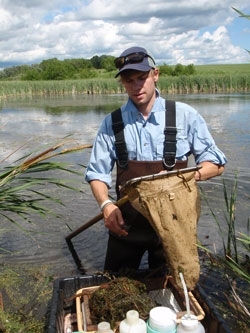
Wetlands are an important part of Minnesota's surface waters, and the MPCA has been increasing its capacity to monitor their quality. The agency's goal is to help ensure Minnesota’s wetlands are protected by providing information to make informed policy and management decisions.
Wetland quality trends monitoring
The MPCA broadly tracks wetland quality over time through statewide and regional random surveys. As with a political poll, we can measure the overall quality of Minnesota’s many wetlands by studying a limited number randomly selected locations. We repeat the surveys periodically to estimate trends and determine if wetland quality is being maintained. The MPCA is currently engaged in two ongoing surveys, sampling on five-year cycles.
The MPCA collaborates with EPA’s National Wetland Condition Assessment to track vegetation quality for all wetland types in the state. The agency sampled most recently in 2021.
The depressional wetland quality assessment targets Minnesota's open water depressional wetlands in the central and former prairie regions of the state where most of these wetlands are found. Macroinvertebrate and water quality are monitored in these iconic wetlands (most recently in 2023).
These surveys complement wetland quantity monitoring efforts by the Minnesota Department of Natural Resources.
Biological monitoring
The MPCA primarily uses biological monitoring to measure wetland quality. The plants and insects that live in wetlands are vulnerable to stressors such as water level alterations, excess sediment and nutrients, and invasive species. These biological communities often respond in predictable patterns to stressors and are reliable indicators of a wetland's condition. The MPCA has developed indices of biological integrity to measure the health of wetland insect communities, including those in depressional wetlands. Similarly, the agency uses floristic quality assessment to monitor the health of wetland vegetation.

Long-term monitoring
For more than twenty years, the MPCA has periodically sampled a small set of depressional wetlands in urban, agricultural, or natural land use settings. The agency monitors macroinvertebrates, vegetation, and water chemistry at the sites. Any trends that are observed may indicate whether large-scale factors such as changes in climate or atmospheric deposition are broadly affecting Minnesota’s wetlands.
Community monitoring
The Wetland Health Evaluation Program (WHEP) is a volunteer wetland monitoring program adapted from MPCA wetland biological monitoring methods that is focused on educating the public and providing local governments with wetland monitoring results. WHEP is currently active in Dakota and Hennepin counties, with a number of cities sponsoring local monitoring teams.